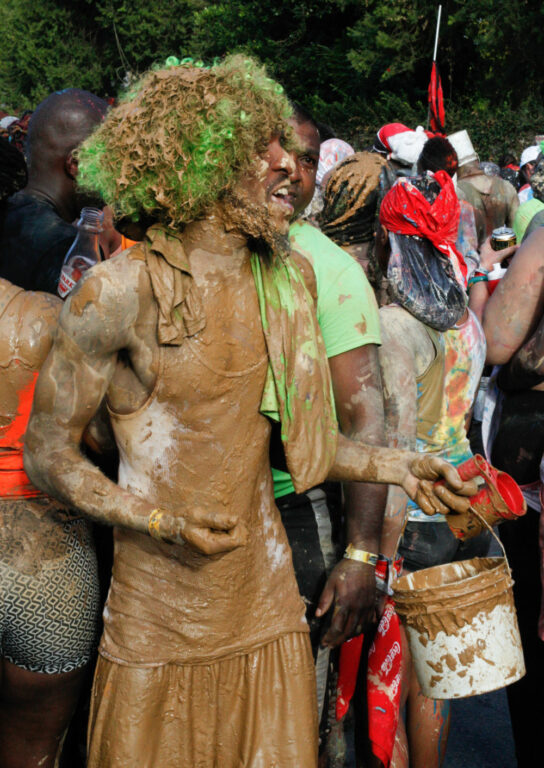
“At 5 am on the Friday before Carnival, on a dark street in downtown Port of Spain, over 100 performers re-enact and celebrate the Canboulay Riots. For an hour each year, hundreds of Carnival fans are entranced as they sit in bleachers and watch what has become – given its starting time and location – a very unlikely hit on the Carnival season during the last several years.”
–Rituals of resistance: the Canboulay Riots re-enactment | Caribbean Beat Magazine
Across the twin island nation, the first Carnival revelers hit the streets to start the celebration by jumping, dancing, “chipping”, singing and dousing their bodies with paint, mud, oil or power.
The procession deals with darker themes than the two-day Carnival parade and one might see revelers dressed with horns, tails and pitchforks. Revelers also dress absurdly in tutus, wigs or as traditional Mas Carnival characters and even make their own costumes for this event. The procession is ritualistic and cathartic for most participants and is an exhilarating feeling to be a part of. You can really feel the historic spirit of rebellion at play in this procession.

These terrifying, fire-breathing characters painted head to toe in blue, wielding their pitchforks with tongues out streaming and wailing with a menacing look in their eyes have stood the test of time and tradition in Trinidad andTobago.
The blue devils’ theatrical cultural showcase is captivating, energetic and vulgar with the Devils contorting, dripping [fake] blood from their mouths, being on all fours and simply “playing the devil”. Surprisingly, children are also among the spectators in the crowds that flock to view. Nowadays there are pockets of groups that keep the tradition alive.
The video below not only shows you examples of the infamous Blue Devils showcase, but also give a behind the scenes look at the technical and theatrical moving parts.
Fighters use 4 foot long sticks made from particular trees such as the pouis tree and enter the ring with their opponent. The first person to draw the blood of their opponent wins the match.
These stickfighting challenges take place once per year during the Carnival season. Watch the video below to feel the energy of the stickfighting finals from carnival 2024. You can observe drumming and percussion music and the dance-like martial art of stickfighting.
There is so much more to explore! See you in Trinidad and Tobago for Carnival 2025 where you can experience the theater of Trinidad Carnival and more for yourself!
Interview with Wan-Jung Wei: OISTAT’s Youngest Executive Director


Megan hails from the twin island nation of Trinidad and Tobago. She is a musician, singer/songwriter with a vast technical theatre background and can be called a rockstar of the creative world. Boasting a holistic understanding of multiple Creative Arts spanning a roughly 16 year career, while being an activist who is passionate about the empowerment of girls, womexn and the LGBTQ+ community, Megan exists at the intersection of the Creative and Cultural Industries and social change. She considers herself a citizen of the planet, having traveled considerably during her career, and is energized by her chosen family and professional networks that span the globe. Megan holds a Certificate in Digital Media Studies with a focus in Music Technology, BFA in Performing Arts with a focus in Theater Design and Production, a Master in Arts and Culture Management (hons) and has a vocation for coaching creatives. Megan also loves writing music, gigging, connecting with people of all cultures and prioritizes having the ocean waves underscore her daily life.
Read Full Profile© 2021 TheatreArtLife. All rights reserved.

Thank you so much for reading, but you have now reached your free article limit for this month.
Our contributors are currently writing more articles for you to enjoy.
To keep reading, all you have to do is become a subscriber and then you can read unlimited articles anytime.
Your investment will help us continue to ignite connections across the globe in live entertainment and build this community for industry professionals.